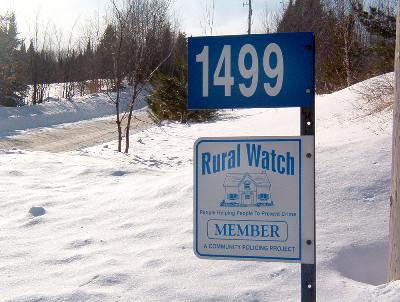 |
March 5, 2004A brief history of crime prevention
|
One source pegs the cost of
crime in Canada – including the police, the courts and the correctional system
at about 60 billion a year. If crime can be prevented the potential criminals,
the victims and the police, courts and correctional system benefit. A lot of
effort ranging from the grassroots in communities to the Federal Government is
now being invested in prevention.
For generations the main focus
on crime prevention was on deterrence and deterrence is still a major thrust
today. Police presence, surveillance, technology, publication of court cases
etc. are geared to making criminals afraid of committing crime. There is also
another growing approach to crime prevention.
 |
One of the Rural Watch Crime Prevention signs seen throughout
several rural communities around North Bay.
|
Since the 1980’s considerable
effort has been put into this new approach often called the “proactive social
development approach”. The Federal Government has developed a National Crime
Prevention Strategy, administered by the Department of Justice and the Ministry
of Solicitor General of Canada. Based on this approach the policy promotes a
strong new emphasis on dealing with grassroots problems that often lead to crime
– poverty, unemployment, drugs, lack of education, etc. etc.
The government is putting
millions into finding ways to change social conditions that cause people to
commit crime.
Community Policing
One example of this change is
having police across Canada balance their deterrence and detection approach with
a move toward involving people and agencies in the community to correct some of
the root causes of crime. This approach is called community policing. In some
cases it means placing more police officers on the street, storefront
accessibility, community officers who visit schools etc. Another aspect of this
approach is the development of community based committees that work with the
police and take a proactive approach to identifying and acting on causes of
crime.
Community Policing Committees
In the N.E. Region of the OPP
there are some 40 Community Policing Committees (CPC) and across Ontario and
Canada there are dozens more. These CPCs vary in their structure and approach
with some only dealing in a reactive way with one issue at a time such as
vandalism and trying to stop it. Most are more proactive emphasizing education
and intervention to prevent the crime from happening.
Chisholm Community Policing Committee
As a member of the decade-long
award winning Chisholm Community Policing Committee in Chisholm Township I can
give an example of a progressive CPC. The Chisholm CPC was initiated when the
OPP approached Chisholm Council in 1993 and explained what community policing
is. The council supported the idea and appointed a committee to write a
constitution and develop a program. The model that was developed included
community members at large with an interest in prevention. One of the keys to
the committee’s success was the decision to include a voting liaison member from
the OPP and one from Council. The OPP and Council members bring concerns and
information from their jurisdictions and report back keeping the partnership
active. Over the years a core group including a representative from the Fire
Department, and others have met regularly to exercise their mandate.
|

|
The Chisholm Community Policing Committee visiting
with Nipper the Crime Stopper Mascot designed by cartoonist Lynn Johnston. |
Chisholm CPC Activities
The Chisholm CPC has carried
out numerous workshops on a variety of topics and has had fund-raisers to
support their activity. The Council Chambers were established as a satellite
OPP office and all the regular CPC meetings take place there. The CPC was
involved in bringing in 911 service and the necessary road names and signage.
They established a centrally located Township Directory with a large Township
map with the new road names and signs advertising various community businesses.
The business space rentals support the work of the committee. Several other
communities have developed directories modeled on the Chisholm design. The CPC
has regular speakers on crime prevention activities and issues specifically
identified are discussed and acted upon by the partners.
Rural Watch
To extend the influence and
effectiveness of the Chisholm CPC a model was developed that has some of the
characteristics of the familiar Neighbourhood Watch/Block Parent models. The
township was divided into sections with an Area Representative in each area.
Signage was provided for some 50 Rural Watch members including the Area
Representatives. These members became the eyes and ears of the community
reporting concerns to the CPC for action. Several other CPCs including Bonfield,
East Ferris and Redbridge have adopted the model including the signage.
Federal Opportunities
As mentioned above the Federal
Government has a community based Crime Prevention Strategy. One section of the
strategy is the Crime Prevention Mobilization Strategy where funding is
available for initiatives that develop knowledge, skills and resources to deal
with grassroots causes of crime.
Chisholm CPC is currently
applying for a grant to bring together CPC members and other stakeholders to
meet and learn about ways to have an impact on their communities across the
North East Region of the OPP.
The object is to have people
return to their communities with a means of identifying and responding to the
social needs of their communities on a sustainable ongoing basis. A proposed
Crime Prevention Website with current information is part of the ongoing aspect
of the proposal. The Chisholm CPC is well on its way toward selecting a site
and program for the conference which will take place when funding is provided.
For further information on any of the activities above contact Larry Ellery,
Chair, Chisholm Community CPC 724-6192, Doug Mackey, Conference Planning
Committee Chair, 724-6882 or Staff Sergeant Irving Sloss, Unit Commander,
Community Policing, North East Region OPP, 495-3878.
Heritage Perspective Home Page
| 
![]() Past
Forward is now on Facebook "LIKE" us to keep in touch
Past
Forward is now on Facebook "LIKE" us to keep in touch